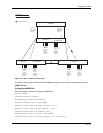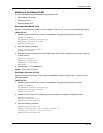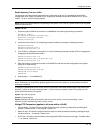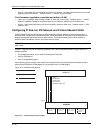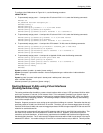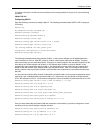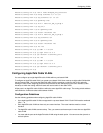
Configuring VLANs
To configure the Layer 3 VLANs and virtual interfaces on the routing switches in Figure 16.12, use the following
procedure.
USING THE CLI
Configuring 9304 A
Enter the following commands to configure 9304 A. The following commands enable OSPF or RIP routing and
IPX routing.
HP9300> en
No password has been assigned yet...
HP9300# configure terminal
HP9300(config)# hostname HP9300-A
HP9300-A(config)# router ospf
HP9300-A(config-ospf-router)# area 0.0.0.0 normal
HP9300-A(config-ospf-router)# router ipx
ipx routing enabled for next power cycle.
Please save configuration to flash and reboot.
HP9300-A(config-ospf-router)#
The following commands create the port-based VLAN 2. In the previous example, an HP 9304M defined the
router interfaces for VLAN 2. With ISR, routing for VLAN 2 is done locally within each HP 9304M. Therefore,
there are two ways you can solve this problem. One way is to create a unique IP sub-net and IPX network VLAN,
each with its own virtual interface and unique IP or IPX address within VLAN 2 on each HP 9304M. In this
example, this is the configuration used for VLAN 3. The second way is to split VLAN 2 into two separate port-
based VLANs and create a virtual interface within each port-based VLAN. Later in this example, this second
option is used to create a port-based VLAN 8 to show that there are multiple ways to accomplish the same task
with ISR.
You also need to create the Other-Protocol VLAN within port-based VLAN 2 and 8 to prevent unwanted protocols
from being Layer 2 switched within port-based VLAN 2 or 8. Note that the only port-based VLAN that requires
STP in this example is VLAN 4. You will need to configure the rest of the network to prevent the need to run STP.
HP9300-A(config-ospf-router)# vlan 2 name IP-Subnet_1.1.2.0/24
HP9300-A(config-vlan-2)# untag e1/1 to 1/4
HP9300-A(config-vlan-2)# no spanning-tree
HP9300-A(config-vlan-2)# router-interface ve1
HP9300-A(config-vlan-2)# other-proto name block_other_protocols
HP9300-A(config-vlan-other-proto)# no dynamic
HP9300-A(config-vlan-other-proto)# exclude e1/1 to 1/4
Once you have defined the port-based VLAN and created the virtual interface, you need to configure the virtual
interface just as you would configure a physical interface.
HP9300-A(config-vlan-other-proto)# interface ve1
HP9300-A(config-vif-1)# ip address 1.1.2.1/24
HP9300-A(config-vif-1)# ip ospf area 0.0.0.0
16 - 23



